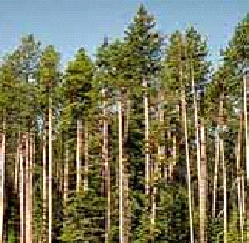Prescribed Burning
By: Lukas Petre (email)

(Figure 1 Caption) A Prescribed fire being set
using a drip torch by the United States
Department
of Agriculture Forest Service.
(USDA Forest Service, 2006).

(Figure 3 Caption) High fuel
accumulations in a dense stand
of lodgepole pine with thick
understory growth.
 d
d prevention became an important national issue. Over this period wildfires decreased in size and frequency. The fire suppression policy brought about changes in forest ecosystems. Fire adapted species have been out competed and fuel accumulation has significantly increased which raises the danger of large destructive wildfires. Fuels buildup in the understory overtime though natural processes. As trees die or as branches fall off this adds to the increase in fuels. Lodgepole pine is a western species that normally has high fuel accumulations because it grows in dense stands. Understory growth and leaf litter can also add to fuel buildup.
Hazardous Fuels
Prescribed burning involves low intensity surface fires. These fires remove fuel accumulated in the forest and therefore the risk of intense fires. Wildfires will inevitably ignite due to human or natural causes and the intensity of the fire is directly related to the fuel type and accumulation. Because the amount of fuel can be significantly reduced by frequent prescribed fires, the severity of these fires is greatly reduced.
Restoring Ecosystems
Public and private landowners restore or improve natural forest ecosystems by conducting prescribed burns. Longleaf pine forests depend on frequent low intensity fires for seedlings to survive. Table Mountain pine, jack pine and pitch pine depend of fire to release seeds from there serotinous cones. In these fire adapted ecosystems, burning promotes seed dispersal and germination, re-sprouting of plants and generally improves wildlife habitat.

(Figure 4 caption) Serotinous
cones of Table Mountain pine.
These cones remain on the tree
for many years and open from
the heat of a fire.